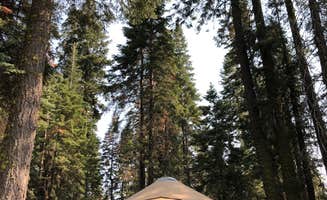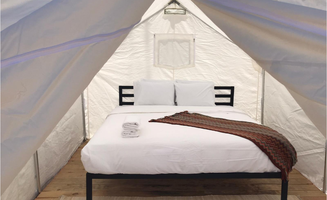The Central Valley climate creates distinct camping seasons near Pixley, California, with summer temperatures often exceeding 100°F and mild winters averaging 55-65°F. Camping options range from developed sites with full hookups to primitive locations in nearby Sequoia National Forest where elevation provides cooler temperatures. Most campgrounds require advance reservations during peak periods from May through September.
What to do
River activities: 3-minute walk to cooling water. At Camp Three Campground, visitors find accessible water recreation just steps away. "Take a 3 minute walk through the woods to get to Kern River and you have a little oasis away from it all," notes one camper. The river features calm areas suitable for swimming and wading, particularly beneficial during hot summer months.
Wildlife viewing: Early morning opportunities. Camping in these foothills provides chances to observe diverse wildlife. "We saw no wildlife besides ground squirrels and some birds," reported one visitor to Sequoia National Forest. Dawn hours offer the best viewing times, with many campers reporting bats and various bird species near water sources. "There were also bats at night that really helped with the bug problem and created a cool ambience while stargazing," observed a camper at Horse Creek.
Stargazing: Limited light pollution. The rural location creates excellent night sky viewing conditions. "The stargazing is beautiful. There is some limited light pollution emanating from the other side of the foothills, but because you are surrounded by foothills you get some good, dark surroundings to really appreciate the stars," shared a Horse Creek Campground visitor. Elevation changes enhance visibility, especially during new moon phases.
What campers like
Natural shade coverage: Variable by site location. Mature trees provide relief from summer heat at many locations. "Sites are big and well spaced from each other," notes a camper at Horse Creek Campground. Tree cover varies significantly between campgrounds and specific sites, with inner loop locations typically offering more shade. "Most sites on the inside of the loop had good tree coverage," confirms another review.
Clean facilities: Regularly maintained. Most campgrounds maintain serviceable restroom facilities despite rustic conditions. "Showers and bathrooms were clean," mentions a reviewer at Visalia-Sequoia National Park KOA. Vault toilets are standard at forest service locations, while private campgrounds typically offer flush toilets and shower facilities, though availability may be seasonal.
Orange picking: Unique seasonal feature. Several glamping sites near Pixley incorporate fruit tree access as an amenity. "We had site 117 and it was a nice spot with no fire pit. Full hookups and really I can't imagine you could have a nicer park in Bakersfield. My son and I enjoyed free orange picking though!" reports a visitor at Orange Grove RV Park. This unusual feature provides a distinctive camping experience not common in other regions.
What you should know
Cell service: Limited or nonexistent. Most camping areas have minimal connectivity. "No cell reception, no WiFi, there are restrooms but no showers. Great place to unplug and decompress," explains a Camp Three Campground visitor. Plan accordingly by downloading maps and information before arrival.
Site selection considerations: Uneven terrain common. Many campgrounds feature sloped sites requiring careful placement. "Nearly every campsite has a major hill, so most will not have a good flat area for a tent," warns a Horse Creek Campground reviewer. Research specific site numbers when making reservations, as conditions vary considerably within the same campground.
Water availability: Check current status. Drought conditions affect water access at many locations. "Google map is not updated/accurate since it shows lake bend is closer to campsites which is not. The drought have made it too far to my liking," mentions a Horse Creek visitor. Call ahead to confirm current water levels and availability, particularly during summer months.
Tips for camping with families
Bear awareness: Storage requirements vary. While bear activity exists, proper food storage minimizes risks. "Each site also has storage lockers for your food, so be sure to lock it up in order to keep the bears from getting into it," advises a visitor to Buckeye Flat Campground. Not all campgrounds provide bear lockers, so verify requirements before arrival.
Swimming access: River locations preferred. Water features significantly enhance family camping experiences during hot months. "We stayed at site #29, where there were nice, flat, soft surfaces to pitch your tent under the trees just beyond where you park your vehicles for privacy and shade. From these gems, the river is just a short, 1 or 2 minute walk," describes a Camp Three visitor. Sites nearest water access typically reserve fastest.
Kid-oriented facilities: Varies by campground. Some locations specifically cater to family camping. "Well run site, with easy late check in process. Friendly on site camp hosts who sell ice and firewood. Quite a lot of rules, and it had kind of a kids camp feel to it," notes a reviewer at Kern's River Edge Campground. Private campgrounds generally offer more structured activities for children.
Tips from RVers
Size limitations: Many campgrounds restrict large rigs. Forest service campgrounds often accommodate smaller RVs only. "We stayed here for a couple nights, the warm weather has been quite appreciated. Lots are spacious and all have a great view," reports a Horse Creek visitor with a roof-mounted tent. Measure your rig before booking to ensure compatibility.
Dump station access: Limited availability. Plan waste management carefully when booking. "The RV Dump station was also unavailable (same reason). During peak season I'm sure this is a great spot, but at the time of our visit it was a bit out of sorts," warns a Horse Creek camper. Private RV parks typically offer better services for larger vehicles compared to forest service campgrounds.



